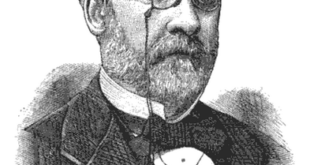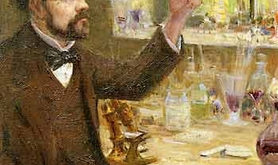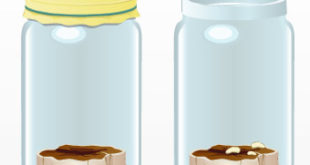A Lecture by David V. Cohn
School of Dentistry
University of Louisville
Feb. 11, 1996
We need no reminder that the foundations of our knowledge of health and disease were constructed by scientific giants who worked decades, even centuries, ago. It is with tributes such as the one today to Louis Pasteur that we pay homage to these great minds — to acknowledge their achievements and our indebtedness to them which we can never repay.
With certainty, one hallmark of Pasteur’s research was not only the importance of his individual discoveries, but the overwhelming breadth of his accomplishment. Pasteur’s long time collaborator, Emile Duclaux, wrote, “A mind … of a scientific man is a bird on the wing; we see it only when it alights or when it takes flight. … We may by watching closely keep it in view, and point out just where it touches the earth. But why does it alight here and not there? Why has it taken this direction and not that in its flight toward new discoveries?”
Pasteur, himself, provided us with an answer: He believed that his research was “enchained” to an inescapable, forward moving logic. As we review today Pasteur’s scientific discoveries we shall see the truth of this statement: how one discovery, one concept, led almost “inescapably” to another.
It may surprise some to learn that Pasteur, the father of microbiology and immunology, was a chemist who launched his memorable scientific career by studying the shapes of organic crystals. Pasteur was 26 years old, working for his doctorate in chemistry in the laboratory of Antoine Balard. Crystallography was just emerging as a branch of chemistry. His project was to crystallize a number of different compounds. Happily he started working with tartaric acid. Crystals of this organic acid are present in large amounts in the sediments of fermenting wine. Often one also found in the sediments in the wine barrels crystals of a second acid called paratartaric acid or “racemic acid”. A few years earlier, the chemical compositions of these two acids, tartaric and paratartaric, had been determined. They were identical. But in solution there was a striking difference. Whereas tartaric acid rotated a beam of polarized light passing through it to the right, paratartaric acid did not rotate the light. This puzzled the young Pasteur. How could this be?
Pasteur refused to accept the notion that two compounds that had the same chemical composition yet acted so differently in respect to rotation of light could be identical. He was convinced that the internal structure of the two compounds must be different and this difference would show itself in the crystal form. The experts in this field had looked examined tartrate and paratartrate crystals but never saw a difference, perhaps because, as Duclaux thought, they believed that no difference could exist. Pasteur believed that there were differences and indeed found them!
Upon intense examination beneath his microscope, he saw that every crystal of pure tartaric acid looked like every other one. When he examined the paratartrate crystals, on the other hand, he saw two types of crystals, nearly identical but not quite! One type was the mirror image the other — the way the right hand mirrors the left hand. This was the difference he was looking for!
Pasteur then performed one of the simplest and yet most elegant experiments in the annals of chemistry. With a dissecting needle and his microscope, he separated the left and right crystal shapes from each other to form two piles of crystals. He then showed that in solution one form rotated light to the left, the other to the right. This simple experiment proved that the organic molecules with the same chemical composition can exist in space in unique stereospecific forms. And with this work did Pasteur launch the new science of stereochemistry.
To Pasteur this discovery had a deeper meaning. He proposed that asymmetrical molecules were indicative of living processes. In the broadest sense, he was correct. We know today that all of the proteins of higher animals are made up of only those amino acids that exist in the left-hand form. The mirror image right-hand amino acids are not used by human or animal cells. Likewise, our cells burn only the right-handed form of sugar, not the left-handed form that can be made in the test tube. It was the discovery of asymmetry of organic molecules that provided Pasteur with the “inescapable forward moving logic” that enchained him as he began his studies on alcoholic fermentation.
Pasteur served on the faculty of science of Dijon for a brief period and then was transferred to Strasbourg University where he continued his studies on molecular asymmetry. In Strasbourg, Pasteur had the immense good fortune to meet and marry the University Rector’s daughter Marie Laurent, who was to be his devoted wife, mother and scientific helpmate through the remainder of his life.
In 1854 Pasteur was appointed Dean and professor of chemistry at the Faculty of Sciences in Lille, France. Lille was an industrial town with a number of distilleries and factories. The Minister of Public Instruction was not completely sold on “science for science’s sake”. He reminded university faculty that (and here I quote the Minister’s words) “whilst keeping up with scientific theory, you should, in order to produce useful and far reaching results, appropriate to yourselves the special applications suitable to the real wants of the surrounding country.”
Pasteur, in contrast to other faculty, needed no prodding. He enjoyed taking his students on tours of the factories and was quick to advise the managers that he was available to help solve their problems. In the summer of 1856, M. Bigot, father of one of his students in chemistry, called upon Pasteur to help him overcome difficulties he was having manufacturing alcohol by fermentation of beetroot. Often, instead of alcohol, Bigot’s fermentations yielded lactic acid.
To better appreciate the discoveries to follow, we should understand what was believed at that time about alcoholic fermentation. Chemistry was emerging as a true science, freed from the pseudoscience of the alchemist. The mysterious chemical processes of living animals were slowly being unraveled in strictly chemical terms. Lavoisier had shown that chemical combustion in living animals was quantitatively identical to that occurring in a furnace. Lavoisier also showed that sugar, the starting product of fermentation, could be broken down to alcohol, CO2 and H2O by simply dropping a sugar solution on heated platinum. Woehler startled the scientific world by sythesizing the organic compound urea, showing for the first time that organic compounds, believed up to then as capable of synthesis only by living animals could be made in a test tube. And due, in no small part to Pasteur’s work on crystals, internal structure and analysis of complex organic compounds was becoming routine.
In this light, fermentation leading to production of wine, beer and vinegar was believed to be a straightforward chemical breakdown of sugar to the desired molecules. The chemical experts of the day proclaimed that the breakdown of sugar into alcohol during fermentation of sugar to wine and beer was due to the presence of inherent unstabilizing vibrations. One could transfer these unstabilizing vibrations from a vat of finished wine to new grape pressings to start fermentation anew.
Yeast cells were found in the fermenting vats of wine, and were recognized as being live organisms, but they were believed simply to be either a product of fermentation or catalytic agents that provided useful ingredients for fermentation to proceed. Those few biologists who earlier concluded that yeast was the cause of, and not the product of, fermentation were ridiculed by the scientific experts: The deep conviction of the scientific establishment was that chemistry had come too far to allow a vitalistic life force theory to challenge pure chemical explanations of molecular reaction. To attribute such chemical changes to mysterious life forces would represent a major backward step in science!.
Unfortunately, the “scientific establishment” was not providing much help to the brewers of wine, beer and vinegar. These manufacturers were plagued by serious economic problems related to their fermentations. Yields of alcohol might suddenly fall off; wine might unexpectedly grow ropy or sour or turn to vinegar; vinegar, when desired, might not be formed and lactic acid might appear in its place; the quality and taste of beer might unexpectedly change making quality control a nightmare! All too often the producers would be forced to throw out the resultant batches, start anew, and sadly have no better luck!
Into M. Bigot’s factory, microscope in hand, came Pasteur. He quickly found three clues that allowed him to solve the puzzle of alcoholic fermentation. First, when alcohol was produced normally, the yeast cells were plump and budding. But when lactic acid would form instead of alcohol, small rod like microbes were always mixed with the yeast cells. Second, analysis of the batches of alcohol showed that amyl alcohol and other complex organic compounds were being formed during the fermentation. This could not be explained by the simple catalytic breakdown of sugar shown by Lavoisier. Some additional processes must be involved. Third, and this may have been the critical clue to Pasteur, some of these compounds rotated light, that is they were asymmetric. As we said earlier, Pasteur suspected that only living cells produced asymmetrical compounds. He concluded and was able to prove that living cells, the yeast, were responsible for forming alcohol from sugar, and that contaminating microorganisms turned the fermentations sour!
Over the next several years Pasteur identified and isolated the specific microorganisms responsible for normal and abnormal fermentations in production of wine, beer, vinegar. He showed that if he heated wine, beer, milk to moderately high temperatures for a few minutes, he could kill living microorganism and thereby sterilize (pasteurize), the batches and prevent their degradation. If pure cultures of microbes and yeasts were added to sterile mashes uniform, predictable fermentations would follow.
The full text of this presentation can be found on the University of Louisville website.
 Pasteur Brewing Louis Pasteur – Science, Health, and Brewing
Pasteur Brewing Louis Pasteur – Science, Health, and Brewing 

